
Battle Rope Wave Squats
Battle Rope wave squats combine a traditional bodyweight squat with the upper body movement of alternating or double waves. This makes squat waves an excellent full body exercise that will get the heart pumping.

Battle Rope wave squats combine a traditional bodyweight squat with the upper body movement of alternating or double waves. This makes squat waves an excellent full body exercise that will get the heart pumping.

Battle rope power slams are an excellent full body strength and conditioning exercise.

There are several ways you can progress any exercise, including:
Speed of movement (faster waves)
Range of movement (larger waves)
Reduce base of support (standing on 1 leg)
Plane of movement (linear to non-linear)
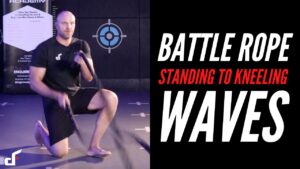
Battling rope standing to kneeling waves are great for building leg strength, trunk strength and will elevate the heart rate.

It’s important to understand good posture when exercising otherwise muscles imbalances can develop, which will in turn hamper your overall power output and increase your risk of injury.

The lower you are to the ground the smaller the waves are. Being lower to the floor needs more power and velocity for the wave to reach the anchor. This increase in power output increases the difficulty of the exercise making kneeling waves more challenging than standing waves.

Battling rope alternating waves are basically the same exercise as double waves apart from your arms are working independently. As you drive one arm downwards towards the floor, you simultaneously drive the other arm upwards.

When you can perform double waves with proficiently, you can progress the exercise by walking towards the anchor point. Begin with 2 steps forwards and 2 backwards, then 3, then 4 etc.

Battling rope double waves are a foundational battling rope movement that hits the arms, shoulders, upper back, abs and quads.

Velocity training is a foundational component of battle rope training. Simply put, battle rope velocity training is the speed and force at which the rope moves (waves).
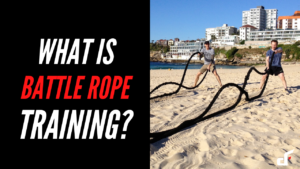
Battle ropes are an incredible training tool. They’re portable, cheap, easy to use, simple to store, high intensity but with low risk of injury and offer a huge range of fitness benefits.

Grip one end of the battle rope in each hand about 10cm from the end, holding the end of the rope too closely from the
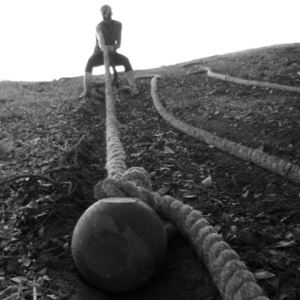
The battle rope is an excellent training tool for performing pulling movements. These strength exercises challenge the pulling muscles in a different way to traditional ‘lever load’ weight training exercises.

When you start training battle ropes only use small to medium size waves ensuring your arms stay between your shoulders and hips.
We include larger waves later once you have proficient technique and have increased your power output and work capacity.

The next progression after kneeling waves is seated waves. Sitting on the floor takes even more legs out of the movement, making you closer to the ground and forcing you to work even faster to reach the anchor point.

If you’re performing forward lunges, you’re stepping closer to the anchor point. The closer you move towards the anchor point, the more slack you have in the rope.

The battle rope power slam is essentially the same as the power slam with the addition of a burpee after every 2-3 slams.

Double wave split jacks are another challenging full body movement that taxes the cardiovascular system. This exercise is a high intensity movement so use short sets with frequent periods of rest.

Battle Rope Hop Waves are a killer leg exercise, if possible, try to keep the hips down low throughout the movement to really work the quads and glutes. Just like the forward lunge you’ll need to produce more force the closer you move to the anchor point, take 3-4 hops forward, then 3-4 hops backwards.

Battle Rope Plank Waves can be performed in various positions working different planes of motion. The battle rope adds variety to the traditional plank and adding a dynamic element to the exercise makes holding the static position even more challenging.

Lateral movement whilst performing waves adds another plane of motion to your exercises. If you’re performing waves, your arms are working in the sagittal plane whilst your legs are moving in the frontal plane. Battle rope alternating lateral lunge waves are an effective full body exercise with the waves targeting the upper body and the lunges hitting the lower body.
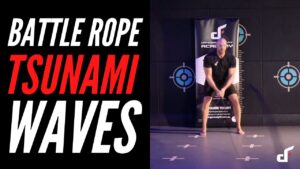
Battle Rope Tsunami Wave exercises involve gripping one end of the rope with two hands with the other end of the rope anchored, this creates a rope that is twice the length of classic battle rope exercises. Having this extra length of rope requires more power to move the wave all the way through to the anchor point.
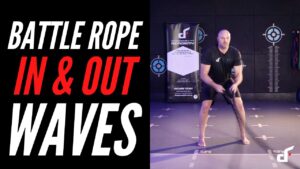
Battle rope in and out waves are great for working your chest, back, shoulders and arms. Like the sidewinder the waves move laterally, but this time move in opposite directions to one another. This movement cannot be assisted with the body which places much greater emphasis on the shoulders and arms.

With battle rope training you have complete freedom of hands allowing you to perform waves in direction that your hands can move. Battle rope Freestyle Waves are basically the same as alternating waves except that your arms move sideways in opposing directions

Battle ropes allow for complete freedom of movement allowing them to go anywhere the hands can go. A great example of this is outside circles, perform this movement using small circles or big circles. This is another exercise that gets little assistance from the lower body which places a much greater workload on the shoulders and arms. Try to create a corkscrew wave that moves all the way through the rope towards the anchor point.
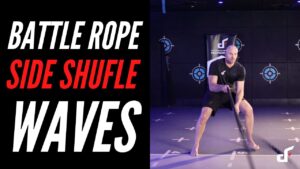
Start with lateral walking, then progress the exercise to a side shuffle to make the movement more metabolically demanding. If you’re training inside and are limited by space, walk/shuffle back and forth. However, if you’re training outdoors and you have the space then try performing a full 360 movement around the anchor point.
Perform the 1st battle rope exercise for 20 seconds with maximum effort, rest 10 seconds then perform the 2nd exercise with maximum effort.

Battle rope diagonal chops mimic the motion of chopping wood and are very effective for building rotational and anti-rotational core strength.
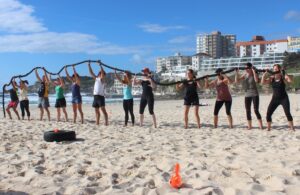
Anchoring the battle rope whilst pressing overhead adds the additional benefit of resisting the weight of the rope pulling back against the anchor point. This
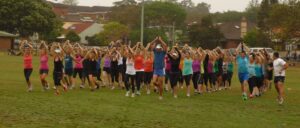
Battle ropes are an excellent training tool for group exercise and boot camps.
When I ran boot camps, I’d train 60-70 people with just 5-6 battle ropes.

This is the same movement as the outward circles except instead of moving outwards, the rope moves inwards. Battle rope inside circles will feel a little more awkward than when performing outside circles and you might find the rope slamming into itself halfway down the rope.

Figure of 8’s is a power exercise that is excellent for challenging the core. Use a microphone grip to lessen the torque going through your wrist flexors. This is another very effective for building rotational and anti-rotational core strength, simple draw the number 8 with your hands as you move the undulations all the way through to the anchor point.
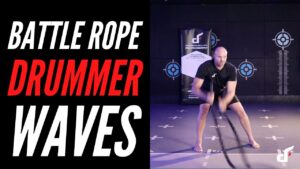
Battle Rope Drummer Waves are another great full body movement which add some additional variety to your exercise repertoire. With this exercise you’ll want to use the microphone grip and try to keep your chest lifted and torso vertical.

Upper cut waves are great for any athlete that requires striking for sports such as boxing and MMA. The movement replicates the movement of throwing an uppercut, so be sure to throw from the hips and pivot the feet as you throw the strike. This exercise is very metabolically demanding and is excellent for conditioning and strengthening the core and shoulders. Try to generate enough force so that the wave goes all the way through to the anchor point.

The grappler toss is a useful exercise for building rotational core strength as well as shoulder and grip strength. Power the movement with a rotational hip drive and pivot. Performing this movement with as much force as possible will also boost your cardio and muscular endurance. Use the microphone grip and ensure the waves reach the anchor point.
Perform the 1st exercise for 10 seconds with maximum effort, rest 10 seconds then perform the 2nd exercise with maximum effort.
Repeat until all the battle rope exercises in the round are complete, then take a 60-second rest and begin the 2nd set.
Perform the 1st battle rope exercise (cardio) for 30 seconds at a fast pace, then go straight to the next exercise (core) without rest. Repeat until all the exercises in the round are complete. The core exercises will be used active recovery between the cardio high intensity exercises.
Perform the 1st battle rope exercise for 20 seconds with maximum effort, rest 10 seconds then perform the 2nd exercise with maximum effort.
Now that the fundamental battle rope exercises are covered, we can begin looking at complexes.
Complexes combine multiple exercises within a set without a rest between each exercise.
Depending on your fitness goals there are many ways to create a complex.
Perform the 1st exercise for 20 seconds, take a 10 second and then perform the 2nd exercise. Repeat until all the battle rope exercises in the round are complete, then take a 60-second rest and begin the 2nd set.
Perform the 1st battle rope exercise for 60 seconds at a steady but fast pace, rest 20 seconds then perform the 2nd exercise. Repeat until all the exercises in the round are complete, then take a 60-second rest and begin the 2nd set.
Free shipping is available for orders with a minimum subtotal of $400 less discounts. Free shipping is only available in Australia and excludes courses and programs.